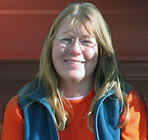In addition to the boxes of artifacts brought back from San Jose, we also had a large bag of soil to process. This latter was recovered from a feature on the last day of fieldwork; we simply did not have time to screen it in the field so we brought it back to the lab. Once I opened the bag I realized that there was no way this was going to sift through our screens; when I dumped it into the screen it kept the shape of the bucket! I hauled the screen out to the yard and proceeded to use water from a hose to push the soil through, leaving the artifacts behind in the screen. These artifacts and animal bones, along with all of the others recovered from across the site were then painstakingly washed with toothbrushes and left to dry in drying racks.
A few days later, when the artifacts are dry, lab processing continues with labeling using pen and ink. Each and every artifact or bone is labeled with a number. The number correlates to the layer in the trench or feature from which the item came. Sometimes we make a game of the process, trying to see who can write the smallest, least obvious but still legible numbers. I used to be a champ.
Finally we begin to sort and catalog the artifacts. By labeling each of them we are free to mix and match them without fear of losing any location information. I randomly began with Feature 102 from Trench 3. Sorting is probably one of my favorite things to do in the lab: lay out all of the artifacts and put all the broken pieces—the plates and bowls and bottles—back together, kind of like a jigsaw puzzle with missing pieces. For analysis, we need to know how many bowls we have, not how many pieces of bowls. You might have five pieces from a single bowl or five pieces from three different bowls.
 Our first feature, No. 102, has 665 fragments of items for a minimum number of 218 objects. There are many fragments of Chinese porcelain bowls, plates and spoons in an assortment of designs, colorless glass dishes and a tumbler. There are also several food storage vessels made of Chinese Brown Glazed Stoneware and a glass canning jar and canning jar lid. A small electric light bulb may have been used in a flashlight. More than 100 nails and tacks were recovered as well as an assortment of metal items. A few stray fragments of opium bowls and liquor bottles were recovered. A few amorphous melted items, lots of window glass, several clothing buttons, a white glass lamp shade, and a milk bottle were also found.
Our first feature, No. 102, has 665 fragments of items for a minimum number of 218 objects. There are many fragments of Chinese porcelain bowls, plates and spoons in an assortment of designs, colorless glass dishes and a tumbler. There are also several food storage vessels made of Chinese Brown Glazed Stoneware and a glass canning jar and canning jar lid. A small electric light bulb may have been used in a flashlight. More than 100 nails and tacks were recovered as well as an assortment of metal items. A few stray fragments of opium bowls and liquor bottles were recovered. A few amorphous melted items, lots of window glass, several clothing buttons, a white glass lamp shade, and a milk bottle were also found.
 All of these items are analyzed, cataloged and entered into a database. At the same time as cataloging we try to assign a date of manufacture to the artifacts, either by researching the mark on the artifact or studying how the artifact was made. For this feature there are several marked items: a plate manufactured in England between 1891 and 1897, a Best Foods condiment jar made sometime after 1903, and an aqua glass Gordon’s Gin bottle manufactured after 1908. Based on this information, we know that the feature was created sometime after 1908, the latest date.
All of these items are analyzed, cataloged and entered into a database. At the same time as cataloging we try to assign a date of manufacture to the artifacts, either by researching the mark on the artifact or studying how the artifact was made. For this feature there are several marked items: a plate manufactured in England between 1891 and 1897, a Best Foods condiment jar made sometime after 1903, and an aqua glass Gordon’s Gin bottle manufactured after 1908. Based on this information, we know that the feature was created sometime after 1908, the latest date.
 Now that everything has been washed, labeled, cataloged and entered we begin to photograph the artifacts and prepare them for final boxing. Artifact tags with provenience information, counts, and description are printed out from the database. The artifacts are then displayed, by feature, and photographed. We call this photograph the “Layout,” it gives a good visual look at all of the artifacts recovered from a feature. Smaller artifact groups are pulled for more detailed “vignette” shots. Once photographed, the artifacts are placed in plastic bags along with their artifact tags and put in archive boxes for permanent storage.
Now that everything has been washed, labeled, cataloged and entered we begin to photograph the artifacts and prepare them for final boxing. Artifact tags with provenience information, counts, and description are printed out from the database. The artifacts are then displayed, by feature, and photographed. We call this photograph the “Layout,” it gives a good visual look at all of the artifacts recovered from a feature. Smaller artifact groups are pulled for more detailed “vignette” shots. Once photographed, the artifacts are placed in plastic bags along with their artifact tags and put in archive boxes for permanent storage.
Erica Gibson
Lab Manager, ASC



































